When we look in the direction of the constellation Sagittarius, we look across a vast gulf of nearly-empty space at one arm of our galaxy's spiral. It's a densely-packed, inner arm, so there are lots of nebulae and star clusters in it. One cloud of gas and dust with a cluster inside is called the Eagle Nebula. The Eagle Nebula is about 7000 light years away from us, and gets as wide as 70 light years. That means the nebula is 70,000 times the width of our solar system!
The Eagle Nebula has been well studied by astronomers using powerful telescopes including the Hubble and Spitzer Space Telescopes.
A long time ago, the most concentrated parts of the nebula collapsed under their own gravity to form stars. The stars are in a cluster near the middle of the cloud. Their radiation has carved out a hole, and we are seeing into it. The stars are ionizing the surrounding gas, so we see its pink glow behind the cluster. Around the edges, we see dark clouds of dust and gas curving around and blocking some of the glowing wall. Those clouds are lit up too, but only on the back side. The densest remaining pockets of gas in the hole are resisting the radiation pressure, and protecting pillars of gas behind them. Astronomers believe that each dense pocket is collapsing to form a new star.
Images taken in infrared light let us see through the dust, and revealed that a supernova explosion occurred in the cluster about 1000 years ago. The expanding shock wave from that explosion is nearing the tips of the pillars. When it reaches them, they will probably be torn apart, but as the gas is concentrated on the edge of the shock wave, more stars will form.
The star cluster in the Eagle Nebula has the more formal name of NGC 6611, and the nebula itself is IC 4703. The whole thing is also known as Messier Object 16, or simply M16.

Back Up to
Deep Space
|
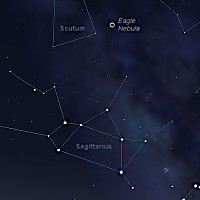
Finder Chart
Regular Size
Caption
Credit: The sky chart program, Stellarium, available at stellarium.org
|
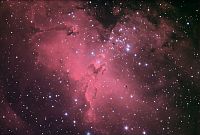
In True Color
Regular Size
Full Size
Caption
Credit: © 2003-2007, John C. Smith, www.hiddenloft.com Used with permission
|
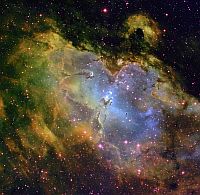
In False Color
Regular Size
Large Size
Full Size
Caption
Credit: T.A.Rector (NRAO/AUI/NSF and NOAO/AURA/NSF) and B.A.Wolpa (NOAO/AURA/NSF)
|
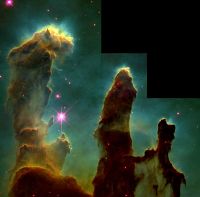
Pillars
Regular Size
Full Size
Caption
Credit: NASA, ESA, STScI, J. Hester and P. Scowen (Arizona State University)
|
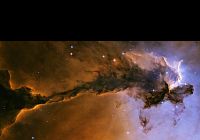
Spire
Regular Size
Large Size
Full Size
Caption
Credit: Credit: NASA, ESA, and The Hubble Heritage Team (STScI/AURA)
|
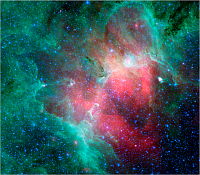
In Infrared
Regular Size
Full Size
Caption
Credit: NASA, JPL-Caltech, N. Flagey (IAS, SSC) & the MIPSGAL Science Team
|
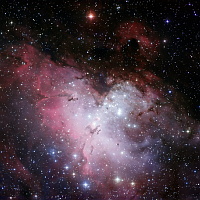
In Enhanced Color
Regular Size
Large Size
Caption
Credit: European Southern Observatory
|
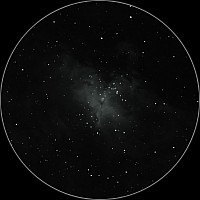
Through a Telescope
Small Size
Regular Size
Caption
Credit: Original image © 2003-2007, John C. Smith, www.hiddenloft.com. Modified by me (Dan Gerhards). Used with permission
|








